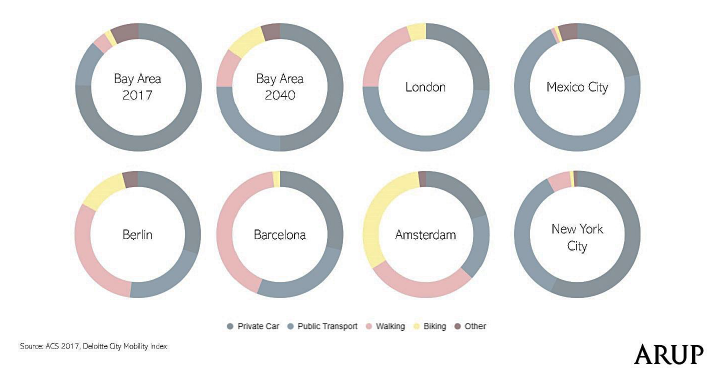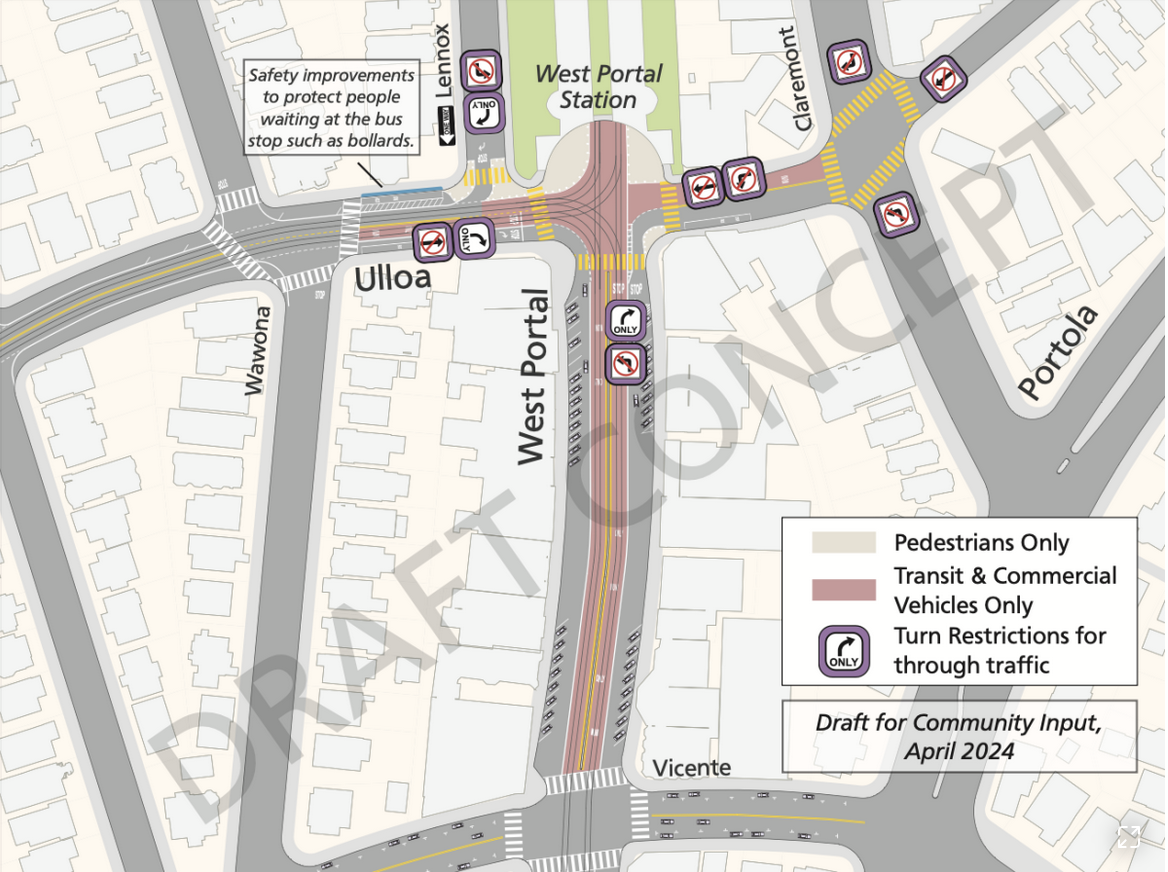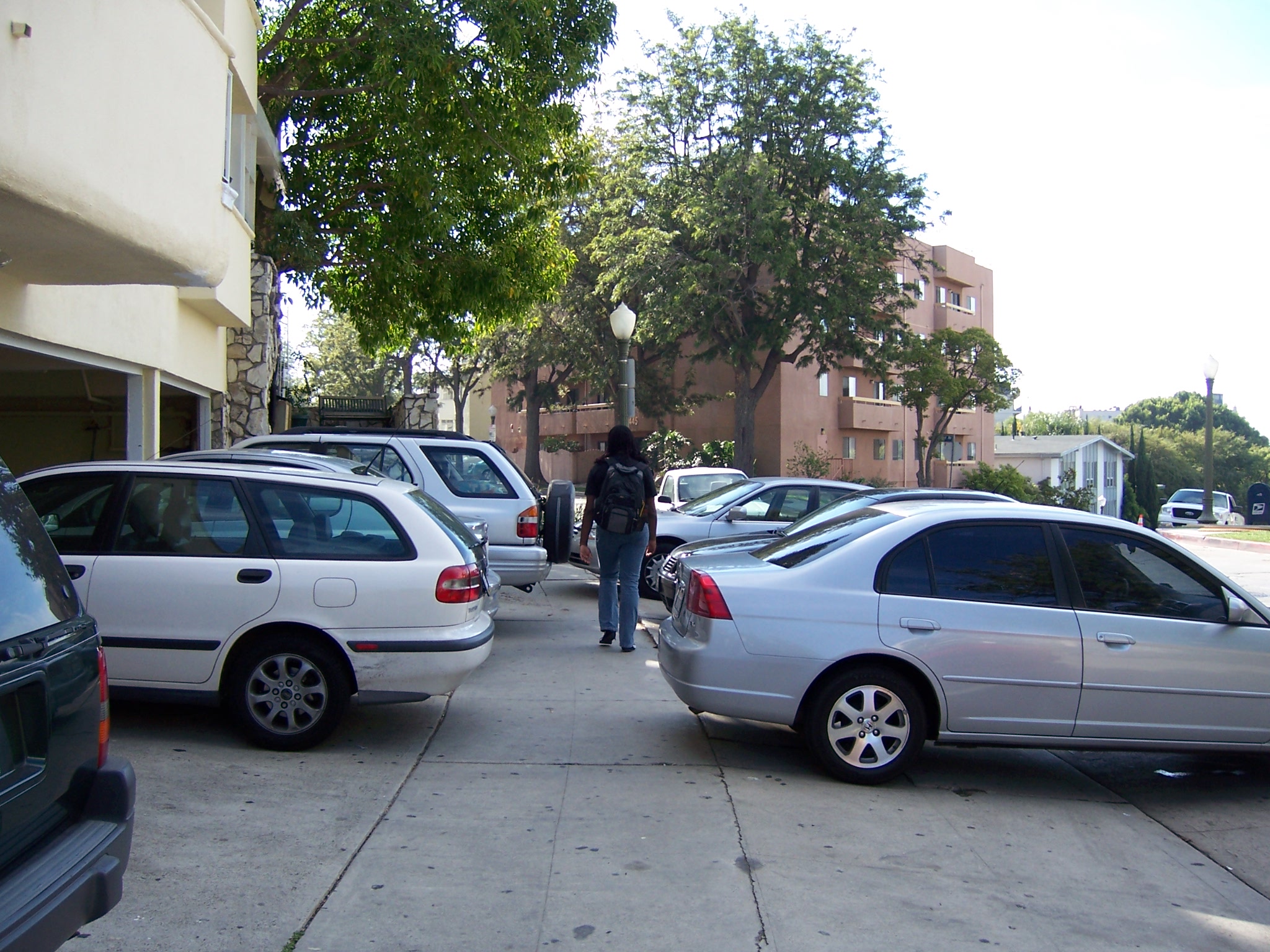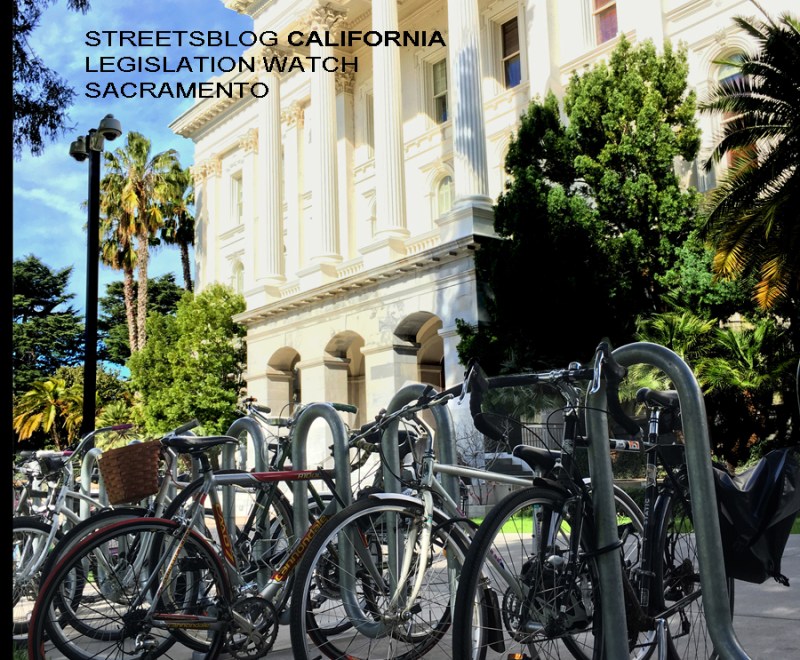Invest in What Makes it Easy to Travel by Healthy, Active, Sustainable Modes
1:58 PM PDT on October 29, 2019

The Bay Area mode share in 2017 is embarrassing; the proposed shift for 2040 isn’t even as dramatic as it could be. Image: ARUP
With the nine-county San Francisco Bay Area about to launch several long-term planning efforts, including Plan Bay Area 2050 and a potential regionwide transportation revenue measure, it's important to get the right priorities into the conversation from the beginning.
If this doesn't happen, the region is likely to continue its usual focus on highway and car-friendly investments, as it has for more than fifty years. People complain about congestion and long commutes, but it's become more and more clear that expanding highways, which encourages more driving, will not improve that situation.
Active, clean modes of travel need to be encouraged and made the norm for a myriad of reasons: congestion relief, air quality, fewer negative health impacts from obesity to asthma, and plain old stress relief.
TransForm recently published its vision for a regionwide bus rapid transit network. Now more than thirty local and regional organizations have come together to create a strategy to help shift people out of cars and into more active modes like biking and walking [PDF].
"It's long overdue for the Bay Area to make a transformational investment in biking, walking, and public transit, and to prioritize black and brown communities that are disproportionately impacted by traffic violence, air pollution, and lack of transportation options," said Ginger Jui, executive director of Bike East Bay, one of the groups that helped formulate the vision.
"Bike East Bay wants to see twenty percent of all trips in the Bay Area made by active transportation by 2050," she added. "We can get there by investing in fantastic people-first infrastructure, neighborhood-based bike programs, bike education in schools, and subsidies for our youth, elders, and lowest-resource communities. A serious investment is what it's going to take to stop wasting time in traffic, reduce greenhouse gas emissions, and create safe streets for everybody."
From some perspectives, twenty percent is an easy goal, because a large number of trips in the region are three miles or under. Those are a "monumental opportunity" for switching to active modes like biking, walking, and scooting. The growing popularity of e-bikes make this goal even easier to reach; the groups have found that e-bikes can comfortably replace car trips up to nine miles long.
The idea is to shift 500,000 or more daily peak-hour commute trips in the region to active modes.
To get there, transportation investments have to prioritize sustainable trips over vehicle trips. That means building infrastructure that makes it easier and safer to get around on bikes and by walking, but it also means investing in programming and education to help create a cultural shift in awareness and use of these modes.
One example of this programming is something like the huge success of CicLAvia, which opens streets in the Los Angeles area to bikes, scooters, and pedestrians to give people the experience with what a quiet, safe, car-free bicycling experience can be. Others are Safe Routes to Schools programs that bring bike education, programming and encouragement to schools.
The organizations have come up with a list of infrastructure investments, policies, and programming that they estimate could reduce vehicle miles traveled on Bay Area roads by 2.7 million miles per day. That in turn could potentially reduce commute travel times, emissions, and stress, and help absorb all the new residents expected in the next twenty years.
These investments could also save people money, making transportation more affordable for everyone, including the lowest income groups that spend the most on transportation.
Done right, these investments could also increase safety for everyone, especially for people who walk and bike.
"The infrastructure, programs, and policies required to transform our region are rapidly deployable, low cost, and will have a high impact on mode shift," according to the letter sent by the groups to regional agencies and staff, elected leaders, and members of the committees working on the potential sales tax measure.
"We need a Bay Area where most people choose active transportation, micromobility, and transit because it is easy, cheap, fun, safe, healthy, and more equitable," writes the report. That requires:
- Transportation choices to be easy and abundant
- Streets to be designed for, and enjoyed by, all people
- Prioritizing the most vulnerable people
- It to be safe and attractive for people of all ages and abilities to walk, bike, and scoot to transit
- Transportation options to integrate seamlessly, be intuitive to use, cost little for users
- Low-income communities to have the same level of transportation options as affluent communities
- Technology to help to support a healthy, active lifestyle
The groups acknowledge that this "transformational mode shift" will require significant investments, arguing that these changes are necessary anyway to reach climate, environmental, and equity goals.
They estimate the total cost for these investments at about $13.2 billion over forty years, to build a complete network of protected "micromobility" infrastructure with pedestrian improvements. The network would need to serve local, intercity, regional, and transit-connecting trips going to school and job centers. The estimate includes crossings over freeways and other barriers, and maintenance.
Education and encouragement programs call for an investment of $1.2 billion over forty years. These include Open Streets programs, educational programs, and Transportation Demand Management programs that offer incentives like bike-share memberships and bus passes to encourage people to shift from driving.
Also key is the ability to transfer smoothly between modes, including bringing bikes on transit but also integrating fares between agencies to make riding them easy and painless. Fare subsidies will also be needed to make active transportation and transit affordable to those people, including students and low-income residents, who would benefit most from using these modes.
It's ambitious, but at the same time it's just a sensible way to think about future investments. Our current practices encourage people to drive by hiding its true costs from drivers, shifting those costs onto others in the form of space given over to cars and parking, prioritizing the time costs of people in cars over people walking or on transit, and allowing emissions that affect health and climate - for starters.
The document recommends policies that eliminate subsidies for driving and parking such as minimum parking requirements in new developments, free parking everywhere, and hiding the cost of parking within household rent. It also recommends several policies to ensure these changes are made equitably, including focusing on underserved areas, and ensuring that transit and active modes are accessible to people of all ages and all abilities.
Transformational investment in people-first mobility over the next decade will result in a sustainable and equitable transportation system for the Bay Area, one that prioritizes the low-cost active modes of walking, biking and micromobility. Future generations will appreciate being able to easily and safely use active modes for their trips, as well as the resulting cleaner air and reductions in greenhouse gas emissions. The Bay Area will join the ranks of other world-class regions around the globe.
The groups that worked on these strategies, which include advocates for active transportation, the environment, smart growth planning, local electeds, planning consultants, and transit, started working on this grand vision last summer, brainstorming "what we need to create a major mode shift," according to Emma Shlaes, policy director for the Silicon Valley Bicycle Coalition, one of the participating groups. They estimate a need for a total of $16 billion in investments for infrastructure, encouragement, programming, and policy changes.
In creating this vision, she said, the groups "were looking for a proactive way to get the needs of the communities met."
$16 billion sounds like a lot of money, but it's spread over forty years and could cost much less than business-as-usual car-focused investments. Shifting investment priorities towards sustainable modes could be dramatically transformative for the region.
"Transformational investment in people-first mobility over the next decade will result in a sustainable and equitable transportation system for the Bay Area, one that prioritizes the low-cost active modes of walking, biking, and micromobility."
The result will be "future generations will appreciate being able to easily and safely use active modes for their trips, as well as the resulting cleaner air and reductions in greenhouse gas emissions. The Bay Area will join the ranks of other world-class regions around the globe."
Signers of the document include:
- Albany Strollers & Rollers
- Bay Area Ridge Trail Council
- Bike Concord
- Bike East Bay
- Bike Fremont
- Bike Menlo Park
- Bike Walk Alameda
- Bikes Make Life Better
- California Bicycle Coalition
- Eisen|Letunic
- Friends of Alto Tunnel
- Friends of SMART
- Greenbelt Alliance
- Lime
- Lyft
- Marin County Bicycle Coalition
- Nancy Buffum Art
- Napa County Bicycle Coalition
- Office of Mayor Tom Butt (Richmond, CA)
- Rails-to-Trails Conservancy
- RideESSJ
- Safe Routes Partnership
- San Carlos Bikes
- San Francisco Bicycle Coalition
- Scoop Technologies, Inc.
- Silicon Valley Bicycle Coalition
- Sonoma County Bicycle Coalition
- SPUR
- Tony, President of Almaden Cycling Touring Club
- TRAC, Trails for Richmond Action Committee
- Waymo
- Winter Consulting Group
Streetsblog California editor Melanie Curry has been thinking about transportation, and how to improve conditions for bicyclists, ever since commuting to school by bike long before bike lanes were a thing. She was Managing Editor at the East Bay Express, editor of Access Magazine for the University of California Transportation Center, and earned her Masters in City Planning from UC Berkeley.
Read More:
Stay in touch
Sign up for our free newsletter
More from Streetsblog California
Automated Enforcement Coming Soon to a Bus Lane Near You
Metro is already installing on-bus cameras. Soon comes testing, outreach, then warning tickets.
Friday’s Headlines
SF plans street redesign at crash site; Santa Cruz commission still supports plan to have both trail and rail; State budget includes subsidies for fossil fuel industry; Unhoused camping; More
Thursday’s Headlines
CA youth speak out on climate: How LA Metro plans to spend $ from canceled 710 freeway; Watch out, illegal SF parkers, tickets are coming; More
Legislators Tackle AV, School Zone Safety
Are AVs freight trucks ready to be deployed on California roads with no one in them?
Metro Looks to Approve Torrance C Line Extension Alignment
Selecting the relatively low-cost hybrid alternative should help the oft-delayed South Bay C Line extension move a step closer to reality




